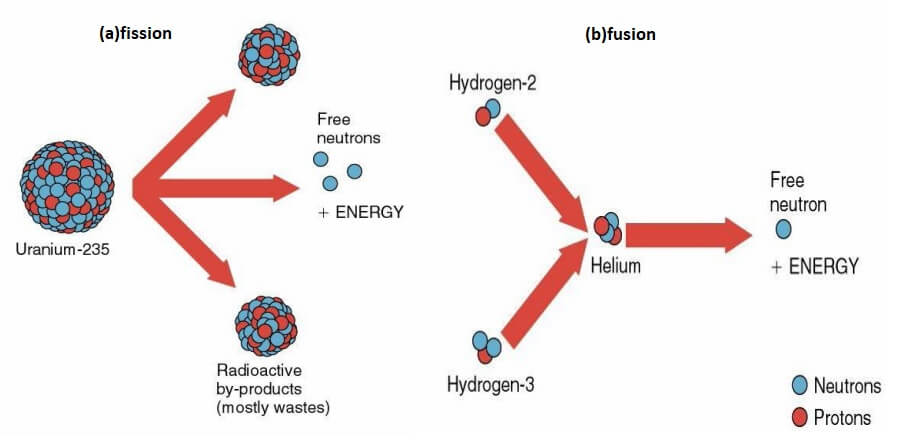Why we go for Nuclear Power Plant?
- Availability of nuclear power plant developed by hydro electric power plants is tremendously affected by monsoon rain from year to year.
- Thermal power plants coal based- coal deposits are concentrated in central and eastern parts of India – coal transport becomes longer and costlier
- Steam, Diesel and Gas turbine power plants are based on conventional sources of energy like coal, oil, and gas- availability of these conventional fuels are fast depleting – while power is ever increasing – India no exception
- So we should look Large alternative sources of Energy
-
-
- Alternatives are
- Solar Energy
- Wind energy
- Nuclear Energy
- Tidal Energy
- At present Nuclear Energy has bright future
- he nuclear fuel used in power industry are principally Uranium and Thorium.
- Large reserves – Thorium
-
- 1 kg of Uranium can produce energy equivalent of 4 x 106 tones of high grade coal
- Nuclear power plant has high initial cost and low operating cost
- Plant becomes more economical if built in large capacities
- Unlimited availability in the sea water
- Availability of water
- Distance from load center
- Distance from populated area
- Waste disposal
- Safeguard against earthquakes
- Accessibility to site
Advantages Nuclear Power Plant
- It reduces the demand on depleting resources of Energy.
- Conventional fuel transportation problem is avoided
- Large storage facilities of fuel are not needed
- Nuclear power plant need less space
- Performance of these plants is high
- These plants are of non-polluting.
Disadvantages Nuclear Power Plant
- Its capital cost is high
- It needs trained manpower
- It has the problem of radioactive waste disposal
Nuclear Energy
Nuclear reactions:
- Fission = one large atom splits into smaller atoms
- Fusion = two smaller atoms fuse to form a larger atom
Fission and Fusion:
- Fission or fusion of an atom produces energy as the conversion from one large into many small (fission) or many small into one large (fusion) doesn’t occur cleanly
- Fission and Fusion: Fission is the process that occurs when a neutron collides with the nucleus of certain of the heavy atoms, causing original nucleus to split into two or more fragments.
- Fusion is the process of combining or fusing two lighter nuclei into a stable and heavier nuclide
(energy is released ‘coz mass of the produced nucleus is less than the masses of the two nuclei. - Both reactions produce energy, neutrons, alpha particles, beta particles, gamma rays (Photons).
Fissile Material:
- Undergoes nuclear fission (splitting of atom) upon bombardment by slow/fast neutrons
- Uranium 235, Plutonium239 and Uranium233
Fertile Material:
- Fertile material is the one which by itself is not fissionable but will capture the neutron and will get
converted to a fissile material - E.g. Uranium 238 becoming Plutonium 239 & Thorium 232 becoming Uranium 233 etc
Nuclear Fuel Burn up
In Nuclear Power Technology, the fuel burn up (also known as fuel utilization) is a measure of how much energy is extracted from a primary Nuclear fuel source. It is measured both as the fraction of fuel atoms that underwent fission in %FIMA (fissions per initial metal atom) and as the actual energy released per mass of initial fuel in gigawatt days/metric ton of heavy metal (GWd/tHM), or similar units.
Expressed as a percentage, burn up is simple: if 5% of the initial heavy metal atoms have undergone fission, the burn up is 5%. In reactor operations, this percentage is difficult to measure, so the alternative definition is preferred. This can be computed by multiplying the thermal power of the plant by the time of operation and dividing by the mass of the initial fuel loading.
For example, if a 3000 MW thermal (equivalent to 1000 MW electric) plant uses 24 tonnes of enriched uranium (tU) and operates at full power for 1 year, the average burn up of the fuel is (3000 MW·365)/24 metric tonnes = 45.63 GWd/t
Decay Rates and Half Cycles
Radioactive wastes are wastes that contain radioactive material. Radioactive wastes are usually by – roducts of nuclear power generation and other applications of nuclear fission or nuclear technology, such as research and medicine.
Radioactive waste is hazardous to most forms of life and the environment, and is regulated by government agencies in order to protect human health and the environment.
Radioactivity naturally decays over time, so radioactive waste has to be isolated and confined in appropriate disposal facilities for a sufficient period of time until it no longer poses a hazard.
The period of time waste must be stored depends on the type of waste and radioactive isotopes. It can range from a few days for very short-lived isotopes to millions of years for spent nuclear fuel.






